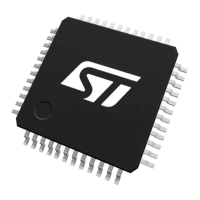FD controller area network (FDCAN) RM0444
1218/1390 RM0444 Rev 5
FIFO is empty. The Tx FIFO enables transmission of messages with the same Message ID
from different Tx Buffers in the order these messages have been written to the Tx FIFO. The
FDCAN calculates the Tx FIFO Free Level TXFQS[TFFL] as difference between Get and
Put Index. It indicates the number of available (free) Tx FIFO elements.
New transmit messages have to be written to the Tx FIFO starting with the Tx Buffer
referenced by the Put Index TXFQS[TFQPI]. An Add Request increments the Put Index to
the next free Tx FIFO element. When the Put Index reaches the Get Index, Tx FIFO Full
(TXFQS[TFQF]= 1) is signaled. In this case no further messages must be written to the Tx
FIFO until the next message has been transmitted and the Get Index has been
incremented.
When a single message is added to the Tx FIFO, the transmission is requested by writing 1
to the TXBAR bit related to the Tx Buffer referenced by the Tx FIFO Put Index.
When multiple (n) messages are added to the Tx FIFO, they are written to n consecutive Tx
Buffers starting with the Put Index. The transmissions are then requested via TXBAR. The
Put Index is then cyclically incremented by n. The number of requested Tx buffers must not
exceed the number of free Tx Buffers as indicated by the Tx FIFO Free Level.
When a transmission request for the Tx Buffer referenced by the Get Index is canceled, the
Get Index is incremented to the next Tx Buffer with pending transmission request and the Tx
FIFO Free Level is recalculated. When transmission cancellation is applied to any other Tx
Buffer, the Get Index and the FIFO Free Level remain unchanged.
A Tx FIFO element allocates eighteen 32-bit words in the Message RAM. Therefore the
start address of the next available (free) Tx FIFO Buffer is calculated by adding four times
the Put Index TXFQS[TFQPI] (0 … 2) to the Tx Buffer Start Address TBSA.
Tx Queue
Tx Queue operation is configured by programming TXBC[TFQM] to 1. Messages stored in
the Tx Queue are transmitted starting with the message with the lowest Message ID
(highest priority).
In case of mixing of standard and extended Message IDs, the standard Message IDs are
compared to bits [28:18] of extended Message IDs.
In case that multiple Queue Buffers are configured with the same Message ID, the Queue
Buffer with the lowest buffer number is transmitted first.
New messages have to be written to the Tx Buffer referenced by the Put Index
TXFQS[TFQPI]. An Add Request cyclically increments the Put Index to the next free Tx
Buffer. In case that the Tx Queue is full (TXFQS[TFQF] = 1), the Put Index is not valid and
no further message must be written to the Tx Queue until at least one of the requested
messages has been sent out or a pending transmission request has been canceled.
The application may use register TXBRP instead of the Put Index and may place messages
to any Tx Buffer without pending transmission request.
A Tx Queue Buffer allocates eighteen 32-bit words in the Message RAM. Therefore the start
address of the next available (free) Tx Queue Buffer is calculated by adding four times the
Tx Queue Put Index TXFQS[TFQPI] (0 ... 2) to the Tx Buffer Start Address TBSA.

